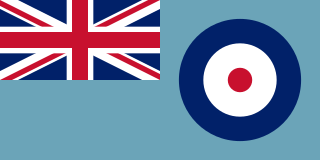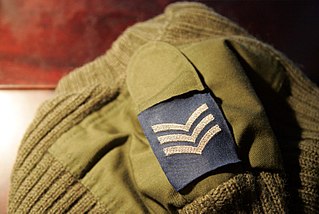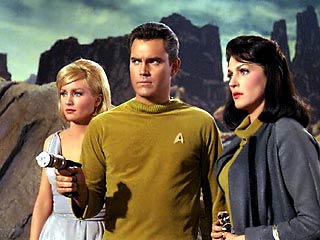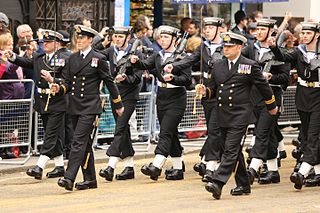This is a table of the ranks and insignia of the Canadian Armed Forces. As the Canadian Armed Forces is officially bilingual, the French language ranks are presented following the English.
The United States Air Force officer rank insignia in use today.
Officer cadet is a rank held by military cadets during their training to become commissioned officers. In the United Kingdom, the rank is also used by members of University Royal Naval Units, University Officer Training Corps and University Air Squadron however these are not trainee officers and most do not join the armed forces.

Listed in the table below are the insignia—emblems of authority—of the British Army. Badges for field officers were first introduced in 1810 and the insignia was moved to the epaulettes in 1880. On ceremonial or parade uniforms these ranks continue to be worn on the epaulettes, either as cloth slides or as metal clips, although on the modern 'working dress' they are usually worn as a cloth slide on the chest. Although these insignia apply across the British Army there is variation in the precise design and colours used and it can take some time to become familiar with them all.

Mess dress uniform is the most-formal or semi-formal type of uniforms used by military personnel, police personnel, firefighters and other public uniformed services members for certain ceremonies, receptions, and celebrations, in messes or on private occasions. It frequently consists of a mess jacket, trousers, white dress shirt, often with standing collar and bow tie, along with orders and medals insignia. Design may depend on regiment or service branch, e.g. army, navy, air force, marines, etc. In Western dress codes, mess dress uniform is a permitted supplementary alternative equivalent to the civilian black tie for evening wear or black lounge suit for day wear - sometimes collectively called half dress - although military uniforms are the same for day and evening wear. As such, mess dress uniform is considered less formal than full dress uniform, but more formal than service dress uniform.
Finnish military ranks form a system that incorporates features from Swedish, German, and Russian armed forces. In addition, the system has some typically Finnish characteristics that are mostly due to the personnel structure of the Finnish Defence Forces. The ranks have official names in Finnish and Swedish languages and official English translations. The Swedish forms are used in all Swedish-languages communications in Finland, e.g. in Swedish-speaking units of Finnish Defence Force. The system of ranks in the Swedish Armed Forces is slightly different.

The officer ranks of the Royal Air Force, as they are today, were introduced in 1919. Prior to that Army ranks were used.
Major (Maj) is a military rank which is used by both the British Army and Royal Marines. The rank is superior to captain, and subordinate to lieutenant colonel. The insignia for a major is a crown. The equivalent rank in the Royal Navy is lieutenant commander, and squadron leader in the Royal Air Force.
Lieutenant colonel, is a rank in the British Army and Royal Marines which is also used in many Commonwealth countries. The rank is superior to major, and subordinate to colonel. The comparable Royal Navy rank is commander, and the comparable rank in the Royal Air Force and many Commonwealth air forces is wing commander.

A shoulder mark, also called a shoulder board, rank slide, or slip-on, is a flat cloth sleeve worn on the shoulder strap of a uniform. It may bear rank or other insignia, and should not be confused with an epaulette, although the two terms are often used interchangeably.

Star Trek uniforms are costumes worn by actors portraying personnel from the fictitious organization Starfleet in the Star Trek science fiction franchise. Costume design often changed between various television series and films, especially those representing different time periods, both for appearance and comfort. Deliberately mixing styles of uniforms from the various series was occasionally used to enhance the sense of time travel or alternative universes.
The Singapore Armed Forces (SAF) has five rank schemes for active and reservist personnel, with a sixth for the auxiliaries of the SAF Volunteer Corps. The rank structure is largely unified, with identical rank insignia across the Singapore Army, Republic of Singapore Navy, and Republic of Singapore Air Force.

The Royal Air Force uniform is the standardised military dress worn by members of the Royal Air Force. The predominant colours of Royal Air Force uniforms are blue-grey and Wedgwood blue. Many Commonwealth air forces' uniforms are also based on the RAF pattern, but with nationality shoulder flashes. Cadets of the RAFAC which includes the ATC and CCF (RAF) Sections wear similar uniforms.

The uniforms of the United States Air Force are the standardized military uniforms worn by airmen of the United States Air Force to distinguish themselves from the other services.

The uniforms of the Royal Navy have evolved gradually since the first uniform regulations for officers were issued in 1748. The predominant colours of Royal Navy uniforms are navy blue and white. Since reforms in 1997 male and female ratings have worn the same ceremonial uniform.
Captain (Capt) is a junior officer rank of the British Army and Royal Marines and in both services it ranks above lieutenant and below major with a NATO ranking code of OF-2. The rank is equivalent to a lieutenant in the Royal Navy and to a flight lieutenant in the Royal Air Force. The rank of captain in the Royal Navy is considerably more senior and the two ranks should not be confused.
A new law approved in July 2008 changed the military ranks of Venezuela, principally with regard to names, functions and commanding regulation of the armed forces. The law was sanctioned by Venezuela's National Assembly.
The rank insignia of the federal armed forces of the Federal Republic of Germany indicate rank and branch of service in the German Army (Heer), German Air Force (Luftwaffe), or the German Navy (Marine).
Lieutenant is a junior officer rank in the British Army and Royal Marines. It ranks above second lieutenant and below captain and has a NATO ranking code of OF-1 and it is the senior subaltern rank. Unlike some armed forces which use first lieutenant, the British rank is simply lieutenant, with no ordinal attached. The rank is equivalent to that of a flying officer in the Royal Air Force (RAF). Although formerly considered senior to a Royal Navy (RN) sub-lieutenant, the British Army and Royal Navy ranks of lieutenant and sub-lieutenant are now considered to be of equivalent status. The Army rank of lieutenant has always been junior to the Navy's rank of lieutenant.






























